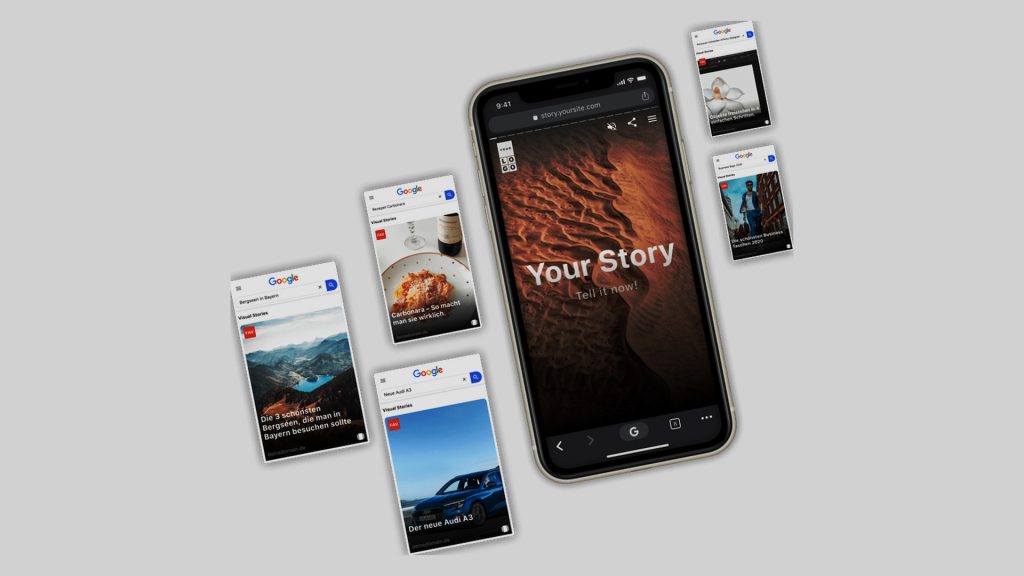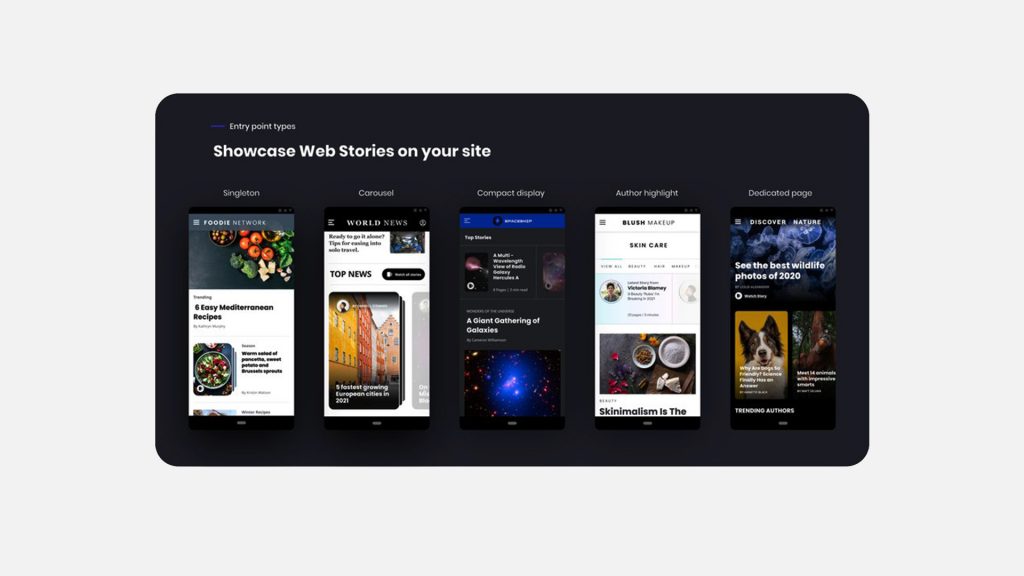In 2015, Google launched Web Stories – or AMP stories. The first run did not attract much attention and remained untouched for a while. Five years later, in October 2020, the giant relaunched Google Web Stories, and this time all heads turned. Web Stories work very similarly to social media stories, and with Google’s large audience reach, they have created a unique opportunity for businesses.
Yet, for many brands, Google Web Stories are still quite unknown. Not everyone knows the benefits of Google Web Stories or how to integrate them into advertising campaigns. That’s why we decided to give you a brief intro to this topic and help you add a new tool to your marketing toolbox.

What are Google Web Stories?
According to Google, Web Stories are “a visually rich, full-screen content format for the web, which allows you to tap or swipe through stories.” Content creators can use web stories to connect with audiences through audio, images, and text.
There are a handful of styles that work with this format, including:
- First-person narratives
- Evergreen or updating stories
- Live stories
- Educational and experiential stories and
- Quizzes and polls
Benefits of Google Web Stories
The small difference between web stories and social media stories makes a big difference in their impact on brands. The benefits of Google web stories are likely far greater than those of other alternative formats. Here are some of the advantages:
Own Your Content!
You have little control over the process when posting stories on a social media platform or on websites like Instagram, Snapchat, or Facebook. You rely on the platform’s interface to create and share the content. With Web Stories, on the other hand, you’re in control from the earliest stages, such as coding, embedding on the website, and so on.
In a way, Google lets you control what you create on its platform. If you want to reach a wider audience, the platform also offers exceptional cross-platform content creation capabilities. This unique advantage allows you to create story content that can be used anywhere.
Customizability
One of the benefits of Google web stories is customizability.Take Instagram stories, for example. In the last few years, many new features have been added to generate creative content formats, but many platform-specific limitations remain. With Google Web Stories, however, there are no limitations on how innovative you can be. Customizability is essential to target different customer personas accurately.
Web Stories offer numerous design elements, including interactive fonts, images, videos, and illustrations. This allows you to optimize the user experience by creating immersive content for various audience segments. From creation to editing to publishing, you have all the tools at your disposal.
Rank Higher on SERP
Ranking high on search engine results pages (SERPs) is a game changer for a brand’s website. The visibility and brand awareness that can be gained by being ranked in the top spots of Google search results is pretty much unmatched. When Google introduced Web Stories, savvy marketers saw a new opportunity to increase their visibility.
Using Web Services is a great way to get your business website to the top of the SERPs, securing the first position and improving discoverability. The power of Web Stories lies in the fact that they can appear on three major Google properties.
- Google Discover
- Google Search
- Google Images

Wider Audience Reach
Google is the most famous search engine in the world. Millions of users access Google every day for a variety of reasons. Leveraging such a lucrative resource is a goal that every company strives for. However, targeting these users in today’s competitive market can be a challenge.
Comparing social media to the Internet is irrelevant regarding audience reach. As popular as they may be, social media platforms have a limited number of users. Google has the most diverse audience segments imaginable, helping brands solidify their inbound marketing efforts.
Improving SEO
Search engine optimization is necessary for any website, app, or online platform. Improving user experience, navigability, visibility, and brand awareness are just some of the benefits of SEO for brands. Web Stories are a great way to boost your SEO visibility.
The reason is that Web Stories are created on Google’s platform. Each has its own page with different codes, which improves your chances of ranking higher in search engine results. Also, unlike many other alternative story features, Web Stories can include links and calls to action and drive more organic traffic to your website.
Tracking Features
Any professional marketer would tell you that Google Analytics is essential to creating a marketing campaign. You may use other tools and software to track performance data and analyze customer behavior, but Google Analytics still holds an important place. The good news is that you can access Google Web Stories and integrate it with Google Analytics with a single click.
We mentioned earlier that Web Stories each have a unique web page address. This allows tracking tools to evaluate and monitor the page’s performance. Google Analytics and Data Studio offer user-friendly tools that help you understand how Web Stories perform on the website or any other media.
Web Stories Can Be Monetized
Last but not least, Google Web Stories can be a great source of revenue generation. Interactive stories are entertaining and engaging. People love to be entertained and are willing to pay the price if you provide them with satisfying content.
Monetization opportunities for publishers can be enabled through full-screen immersive ads, programmatic ad solutions (AdSense and Ad Manager), and affiliate links. This way, you reach your audience with a new story and provide them with an exciting experience. This, in turn, converts them into paying customers who appreciate customized targeting experiences.
How to create Google Web Stories
Looking at the most successful Google Web Stories examples, we can sketch out a general scheme for how to create Google Web Stories with the most impact:
- Select a visual editor
- Draft the story
- Add visual elements (images, videos, etc.)
- Create the Web Story
- Publish
Bottom Line
Web Stories may sound and look like their competitors on social media platforms, but you can now see how powerful they are. Incorporating them into your marketing efforts can improve your brand’s visibility and broaden your customer base. It’s also a great way to engage your audience.
To learn more about market-proven tactics and strategies, get in touch with us.
Related Post
Publications, Insights & News from GTECH








